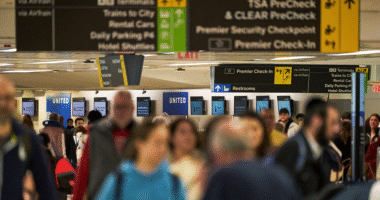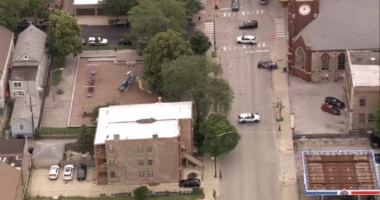
A group of pole dancers in Greece has caused anger after a video surfaced of them conducting an underwear photoshoot in front of the historic Old Palace on Corfu.
Videos shared by Greek media depicted British tourists observing the dancers outside the Palace of St. Michael and St. George during the early hours of the morning.
Two women were seen balancing together on a pole in bright red underwear.
Protothema assessed: ‘Understandably, there were several reactions regarding who gave permission for such a photo shoot in the city centre.’
The Old Palace, a former royal residence built by British Lord High Commissioner Sir Thomas Maitland and architect Colonel George Whitmore, is situated prominently in the Old Town of Corfu, recognized as a UNESCO World Heritage site.
Dozens of residents expressed furious reactions on social media over the photoshoot in little clothing outside the historic palace. Some commenters claimed that the dancers were British.
‘The Corfu Palaces: they once hosted royals. Now, pole dancing,’ commenter Panagiotis Kalogeros wrote on Facebook.
‘If Lord Byron saw pole dancing at the Palaces, he would have returned to England without a second thought.’
‘Would they do the same at Buckingham [Palace]?’ wrote another. ‘Of course, here we have been the inferior in Europe for years on vacation and binge. [sic]’
Another worried how the pole was supported, fearing ‘that they pierced the slabs in the ground’ to hold it in place. There was no evidence the site had been damaged.
The Palace of St. Michael and St. George was designed by British architects in the early 19th century, using neoclassical styles typical of the time.
For more than two centuries it has stood in the old city of Corfu, which has been on the UNESCO World Heritage List since 2007.
The building is still in use today and remains a well preserved instance of Regency architecture towards the end of the Georgian period.
Greek users on Facebook were anxious that part of the site could have been damaged during the photoshoot, several asking how they gained permission.
‘Did the permanent residents of the historic center and their association take a position for this event?’ one asked.
‘Who gave the permission slip???’ said another.
‘Someone should call the police,’ added a third.
The Directorate of the Museum of Asian Art, today housed inside the palace, was unaware of the event, according to local media.
Not all abhorred the dancers for performing outside the historic building, however.
User Bill Metallinos defended the performance.
‘Basically, what we see is the backstage of some photography,’ he said of the video.
‘Otherwise dancing is part of culture[.] it’s just that this one is misunderstood…
‘Yes the concept offends the monument but as an open space unguarded and unmarked disappointing swimsuits or extra items I see no reason someone who wants to take photos to be banned, it is an open public space.
‘But to see how hypocrit[ical] we are, we have passed a road of heavy vehicles through the Palace and under its Arch and we are sending all the exhaust pollution to Tufopetra that has been consumed by all this fuel gas…
‘And instead of shouting about the damage we are doing to it we ourselves are shouting about the photography that was done by some professionals in the area.
‘In the end, who damages the monument? Them or us?’
Another user disagreed and expanded: ‘What do traditional dances have to do with stripping there?
‘Me personally if my daughter was there I would be ashamed.’
The palace in Corfu was built over a five year period in the immediate aftermath of the Napoleonic Wars.
The defeat of Napoleon at Waterloo in 1815 saw the Ionian Islands, including Corfu, become a protectorate of the UK through the Treaty of Paris.
In turn, Corfu became the seat of the British Lord High Commissioner of the Ionian Islands.
It was Sir Thomas Maitland who commissioned the Palace of St. Michael and St. George as the official residence for the Lord High Commissioner.
There was a boom in Regency architecture building across Britain and its overseas holdings after the end of the Napoleonic Wars as government spending steadily recovered and timber shortages eased without the war demand.
Closer to home, examples of Regency architecture can be seen in the work of John Nash across London.
Britain revived some of the classical architectural styles of the Greeks and Romans during its imperial rise, after architects like Inigo Jones brought back to the British Isles techniques recovered by the Italians through the 16th and 17th centuries.

















